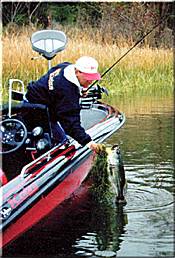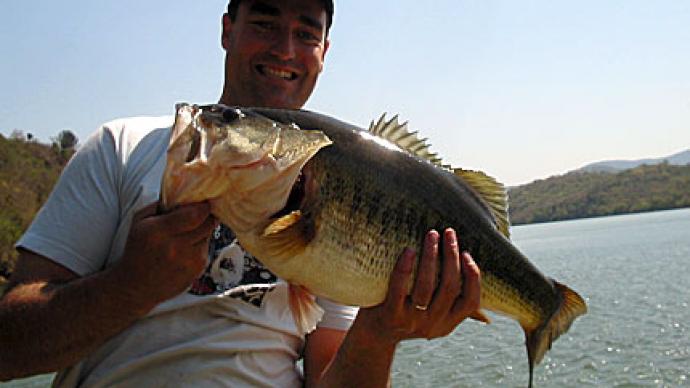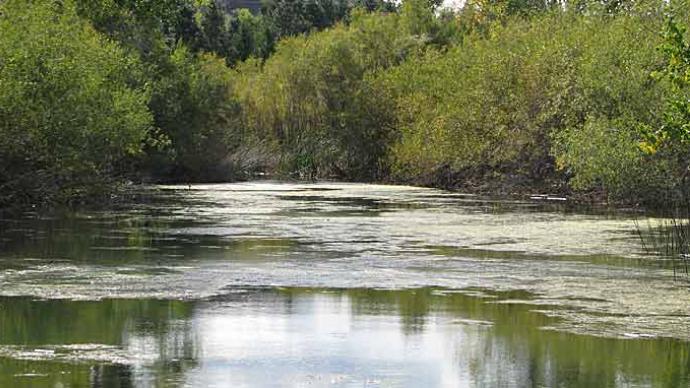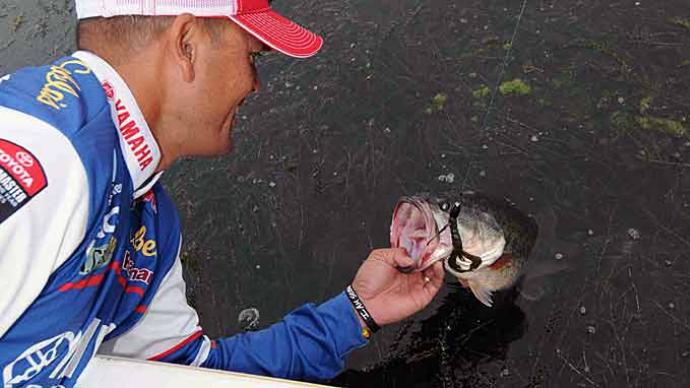
As a youngster, I spent considerable time avidly studying in nature's classroom. My labs were the small farm ponds and streams where I tried to soak up as much about nature's plan as possible. Sure, I liked to fish and hunt, but I enjoyed listening, watching, and learning. While they weren't Silver Springs, there were several very clear farm ponds, which had a good population of fish and vegetation.
The relationship of bass to the growth of water plants was very conspicuous. If you remained quiet and peered down into the canyons between the moss, you could see the larger fish lie in the shadows. Or, if you had enough patience, you could watch one dart out to zap a careless bream.
I remembered those images when I planned my recent trip to Lake Fork (Texas). I intended to pitch jigs into pockets within the hydrilla. You remember hydrilla, the weed that grows at six feet per hour and has been reported to grow totally around the boats of some crappie fishermen while they are anchored.
I had a slightly different problem with this indestructible water plant. You see, the issue was that none of it existed at the first five summertime holes I intended to fish. Sure there were some patches on the lake if I looked hard enough, but like Rayburn over the last several years and the same for The Pines 30 years before, thick matted areas one year suddenly gave way to the bare bottom the next.
I eventually did find hydrilla beds and worked them with several productive techniques that can be applied anywhere vertical and horizontal vegetation exists.
As in the farm pond, vegetation holds baitfish and predators that feed on them. There is an interesting correlation between vegetation growth in a lake, soil quality on the bottom, water quality in general, and water clarity. While plants help filter the water, they are also vulnerable to toxic influx into the watershed and subject, as are land plants, to overall changes in the quality of their environment.
Free-floating Surface plants such as water lilies, duckweed, and water hyacinths can grow more independently of water clarity since the leaves are on top and can catch sunlight to sustain the plant. Underwater growth, where the leaves are submerged as part of the main stem, is limited to maximum depth by their need to catch the sunlight. Therefore, the muddier the lake, the shallower they have to grow.
The depth at which the underwater plants grow predetermines how likely they are to hold fish in midday or act mainly as early and late holding areas. The rule of thumb is that bass like shade and cover, as do many forage critters. Where the plants have both vertical and horizontal components, the bass can get under the canopy and don't necessarily leave for deeper water in midday periods. This is why you can catch bass in four feet of hydrilla if the growth is sufficiently thick. It doesn't always grow like a packed hay bale but has holes or channels below the top mat. The same logic applies to water lilies. Sure, you can catch fish around the edges early and late, but most folks don't realize the bass is often as likely to move back shallower into the thicker pads than leave the bed and head to deeper water during the day.
Our challenge is to exploit the thicker vegetation and catch the fish out of the pockets. The first places I learned about how to fish thick hydrilla mats were Sam Rayburn and Toledo Bend (both in Texas). The entire mode of summertime fishing was changed by folks learning how to "crash" the mats rather than waiting for the fish to come to the edge or top before being able to catch them. The first style was the use of a pegged worm or lizard. This was reasonable, but later having to acknowledge that you could work a jig-and-pig more successfully in mid-summer (a bait I knew could only be fished in the winter months) was a little hard to buy. I am a slow learner, but I learned to hunt the thick stuff rather than complain about it. While it is always fun to watch a bass crash through the thick stuff after a weedless spoon or frog, more often than not, you need to go through it to get them to strike.
Reeds are another common type of water vegetation. The problem with reeds is that they offer little horizontal cover during midday periods. The growth doesn't offer much of a canopy, to begin with, and the problem is made more complex in that most don't grow in very deep water. If shade is an essential factor in holding bass, then these plants can best be considered shadow makers. What they lack in blocking the more direct sunlight they tend to overcome by their sheer mass in casting shadows in angled sunlight.
This means that if bass migrate to shaded banks in the evening and stay in such shaded areas longer in the morning, the banks with cattails and reeds further enhance this trend to create shaded holding areas.
The impact of wooden structures can best typify the value of shade in bass fishing. A stump, for example (even a large one), offers a limited shade area in mid-day. However, a log lying in the water always offers shade no matter the sun's angle. So it is no surprise the latter is usually more productive for holding fish.
If the lake you fish fluctuates very much, a lot can be learned from low-water conditions. For example, a rather non-impressive area of stumps may be a real fish apartment if wave action worked the dirt away from the bottom during lower water levels, which leaves a tangle of roots and a great canopy of the main stump.
Whether you are fishing pockets in vertical growth or gaps in reeds, your presentation is often critical. If the bass are locked into a shaded hole, a vertical and very accurate presentation is necessary. I might add that the strike often occurs on the drop, so you must keep line control on the fall. I didn't say to use a tight line because it makes the bait come forward as it drops. Instead, you want it to go straight down to the target area.
If you are using a jig, try to learn how to tie a good loop knot. The way a jig swings on a free pivot off a loop knot versus the stiff orientation on direct ties will be evident if you submerge the bait below the water next to your boat. It also tends to be more weedless on the fall with a loop tie.
Vegetation is an incubator for aquatic life and a haven for bass. Think of the shadows that the growth casts and the water depth around the growth, and determine if you want to fish through or on top of the growth.
I have always believed in the truism that if you find good growths of various vegetation types on a lake, you can find bass somewhere around or in it during the day.




